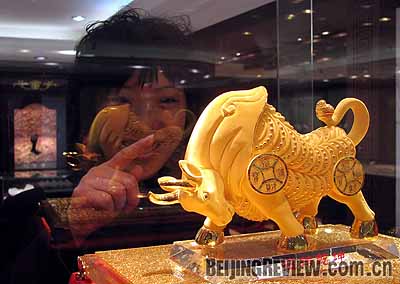| Numbers of the Week
324.9 billion
China's fiscal revenue in December 2008 stood at 324.9 billion yuan ($47.5 billion).
282 tons
China produced 282 tons of gold in 2008, making it the largest gold producer in the world.

TO THE POINT: As part of global effort to reverse the economic slowdown, China announced plans to revive the nation's textile and equipment manufacturing industries by offering them more favorable policies. Meanwhile, the government decided to invest as much as $85 billion in building new-energy power plants in 2009. Taking advantage of the world economic downturn, Sany Heavy Industry embarked on establishing a 100-million-euro research and development center and manufacturing base in Germany. Consumption remained robust in the country, as people spent a total of $42.4 billion during the seven-day Spring Festival holiday. Meanwhile, the iron and steel industry is to rebound after suffering a big loss in the fourth quarter of 2008.
By LIU YUNYUN
Revitalizing the Textile and Equipment Manufacturing Industries
As part of the nation's efforts to tackle the domestic economic slowdown, the government passed readjustment and revitalization plans for the textile and equipment manufacturing industries on February 4.
The major contents of the two plans were passed at an executive meeting of the State Council chaired by Premier Wen Jiabao. The meeting recognized the textile industry as a traditional pillar industry of China's economy with a notable comparative advantage in the international market. It was also deemed an important industry closely related to people's livelihoods.
The meeting proposed the following five measures to boost the textile industry:
- Actively expand domestic consumption, innovate new products and explore the vast rural market.
- Improve the technology and build-up of independent brands, and set up a special fund in the central investment package to upgrade technological advancements in the spinning, dyeing, and production of chemical fibers.
- Eliminate outdated production technology and high energy-consuming and polluting production facilities, and offer favorable policies to backbone enterprises to acquire enterprises with outdated production facilities.
- Optimize the regional industry layout by encouraging textile manufacturers to move to the central and western parts of the country.
- Raise the garment export tax rebate to 15 percent from 14 percent and offer credit support to enterprises with relatively sound business structures that have been troubled by the financial crisis. The central and local governments will buy more cotton and silk.
The meeting also noted that the equipment manufacturing industry is a capital-intensive industry with great strategic significance. It set forth the following four measures to boost the industry:
- Encourage enterprises to produce machinery with independent research and development in the fields of clean power generation, super high and high voltage power transformation, coal and metal mining, natural gas pipeline transmission, express railways, and urban light rail systems.
- Promote automation in equipment manufacturing.
- mprove the technological levels of accessories such as large-scale casting, forging and cutting machines.
- Encourage mergers and acquisitions among backbone enterprises to create large conglomerates with global competence and set up industry revitalization and technology reform funds in the central investment package.
Spring Festival-a Consumption Carnival
The Chinese lunar New Year, also known as Spring Festival, was fervently celebrated on January 25-31, despite the shock of the global financial turmoil.
The Chinese spent 290 billion yuan ($42.4 billion) during the most important national holiday, an increase of 13.8 percent over the last year's holiday period, according to the Ministry of Commerce.
During the Spring Festival, shopping malls offered attractive promotional activities such as discounts and lucky draws, while local businesspeople organized various kinds of temple fairs to sell their products. Meats, vegetables, fruits, health care products, gift packages and alcohol were the bestsellers.
| 